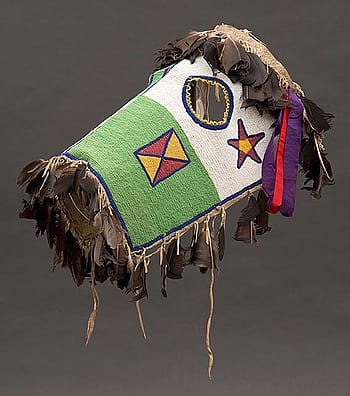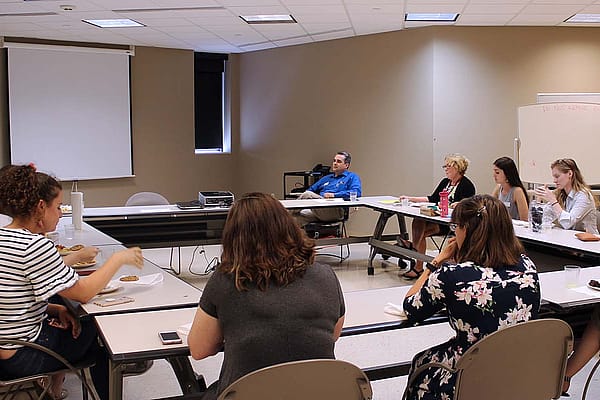
Art of the Buffalo Culture Era: The Paul Dyck Collection – Points West Online
Originally published in Points West magazine
Summer 2014
Art of the Buffalo Culture Era: The Paul Dyck Collection
By Emma I. Hansen
Plains Indian Museum Curator Emerita
On June 15, 2013, the Plains Indian Museum at the Buffalo Bill Center of the West attained one of its goals for the Paul Dyck Plains Indian Buffalo Culture Collection: the public opening of the permanent gallery devoted to this superb collection of Native American artistry.
Almost four hundred people—including Dyck family members—had attended the Patrons Opening of the gallery on the previous evening. After singing and drumming by the Fights Alone Drum Group from Pryor, Montana, Crow elder Heywood Big Day smudged and blessed the collection and the exhibition gallery as a prelude to the formal presentations. Oglala Lakota artist and Plains Indian Museum Advisory Board member Arthur Amiotte, and the Center’s Chairman of the Board of Trustees, Barron Collier, presented eloquent and meaningful observations about the Paul Dyck Collection and its significance in the study and understanding of Plains Native arts, as well as in the museum’s present and future exhibitions, publications, and programs.
Reflecting the continuity of Plains artistic and cultural traditions from the buffalo-hunting days to contemporary life, the 2013 Plains Indian Museum Powwow also commemorated the opening of the Dyck Gallery. Throughout the weekend, Powwow dancers and museum visitors alike enjoyed participating in the Powwow as a celebration of tribal heritages and contemporary artistic expressions, and viewing the magnificent pre-reservation art of the Paul Dyck Collection.
The Buffalo Culture Collection
The Paul Dyck Plains Indian Buffalo Culture Collection constitutes the life’s work of an individual with a mission: to assemble the finest examples of Plains Indian arts available to him and build a museum to exhibit the collection with an interpretation based upon his own study of Native cultures and histories. With origins in his father’s collection begun in 1886 when he lived near the Blood Reserve in Alberta, Canada, Paul Dyck systematically expanded his collection over many years to represent excellence in Plains artistry and creativity through long-standing friendships and family relationships with Blackfeet, Crow, Cheyenne, Assiniboine, Arapaho, Nez Perce, Pawnee, Kiowa, Comanche, Otoe, and other Plains Native peoples.

This collection of approximately two thousand objects includes excellent examples of hide clothing including men’s war shirts, women’s dresses, children’s clothing, moccasins, and leggings; cradles decorated in beads and porcupine quillwork in culturally distinctive designs; buffalo-hide tipis and furnishings; painted buffalo robes, shields, and weapons; pipes and pipe bags; bear claw necklaces; eagle feather bonnets; and peace medals dating from the late 1700s to the 1890s. Dyck identified this period as the “Buffalo Culture” era.
The acquisition of the Paul Dyck Collection provides an opportunity for the museum to enhance and extend back in time the story of Plains Indian peoples—their arts, cultures, and histories—using unique cultural materials previously underrepresented in our collection. Amiotte has stated that the objects in this collection can be considered as the “grandparents” or even “great grandparents” of our existing Plains Indian Museum collection primarily consisting of late nineteenth century to contemporary materials. Native and non-Native scholars and interested tribal community members have indicated that they look forward to studying the Dyck Collection and assisting in its appropriate conservation, storage, and interpretation.
Plains Indian Museum Advisory Board member Marilyn Hudson from the Mandan, Hidatsa, and Arikara Nation said, “This is a beautiful, one-of-a-kind collection. It’s most important that something of such beauty be cared for properly and preserved for many future generations.”
Many of the objects in the Paul Dyck Collection are recognized as masterworks of Native American art and characterized by the shaping of such raw materials as porcupine quills; buffalo, deer, and other hides; natural pigments; stone; wood; and horse and human hair into beautiful clothing, moccasins, household and other functional items, weapons, and ceremonial objects. In addition to their intrinsic artistry and creativity, such works also are powerful and often multilayered expressions by Plains Native artists of their cultural knowledge and understandings, values and traditions, biographical and historical experiences, and a spirituality that guides all aspects of life.
The Plains Indian Museum acquired the Paul Dyck Collection in September 2007 through the generosity of the Dyck family and additional gifts of the Nielson Family and the Estate of Margaret S. Coe. Many scholars of Native American art have long considered this collection to be one of the most comprehensive, privately-held assemblages of pre-reservation and early reservation arts and related historical materials documenting the lives and cultures of the Native people of the Great Plains. Beginning in 2008, under a three-year Save America’s Treasures grant, museum staff processed, documented, photographed, researched, catalogued, conserved, and provided optimum vault storage for this collection. The significant outcome of this work is the preservation of this remarkable collection as an accurate representation of the unique cultures of Plains Indian peoples and, consequently, making it available to the public through research, exhibition, and publication.
Paul Dyck Plains Indian Buffalo Culture Gallery
The Dyck Gallery is a permanent exhibition gallery located in the lower level of the Plains Indian Museum. Eighty objects with accompanying interpretation are currently on exhibition. In addition to the selected objects representing cultures from throughout the Great Plains, historical photographs— including many from Dyck’s collection—illustrate the themes and provide contexts for the collection objects. The gallery exhibition begins with an introduction to the “Buffalo Culture Era”:
At the beginning of the nineteenth century, Plains Native people were buffalo hunters and farmers with the freedom to follow a yearly ceremonial cycle and to travel by horseback to hunt, gather plants for foods and medicines, and trade. Yet, by 1890, the destruction of the once great buffalo herds, disease, warfare, starvation, and government policies forced the tribes to the confinement of reservations. The Buffalo Culture Era had ended. Still, Plains Indian people endured through their arts, spirituality, and the teachings of long-held traditions to their children and grandchildren.
The exhibition follows several themes related to the Buffalo Culture Era: Plains Indian People and Their Horses, Symbols of Leadership, Hunting and Warfare, Protective Power of Shields, Shirts of Honor, Women’s Artistry, Creating Beautiful Dresses, and Messages to the Heavens.
Plans call for periodic rotation of objects in the gallery for conservation reasons, and to make more objects available for public viewing. Current highlights of the gallery include a beautiful and powerful Central Plains bear claw necklace dating from about 1860. Also on exhibit are rare women’s ceremonial clothing, including a Kainai (Blood) Motokiks Society buffalo horn bonnet (ca. 1860) and a buffalo cow dance apron from the Southern Arapaho (ca. 1890). Women wore such aprons during the Arapaho women’s buffalo cow dance ceremony, called the bänuxta ’n wu, held in honor of the buffalo.

Amiotte provided information on the Miwitani (Owl) Society sash from the Oglala Lakota on exhibition. The sash dates from about 1850 and is made of blue trade cloth and decorated with golden eagle, raven, and owl feathers, and beaded thunderbird designs. Shown with this sash is a drawing by Amiotte’s great grandfather Standing Bear that depicts a warrior wearing a similar sash during a warriors society dance. Through this society, warriors pledged to sacrifice their own lives in battle to defend their comrades. The exhibition also includes a muslin painting by Crow scout White Swan depicting his experiences in the Little Bighorn Battle.
Touring exhibition and catalogue
With the completion of the Dyck Gallery, Plains Indian Museum staff is now concentrating on plans for a touring exhibition and catalogue, titled Coming Home! Legacies of the Paul Dyck Plains Indian Collection. Planning meetings with scholars, consultants, exhibition designers, and Plains Indian Advisory Board members continue through the spring of 2014 with support from grants from the National Endowment for the Humanities and the National Endowment for the Arts. The exhibition opens at the Center in 2016 before traveling to major national and international museums.
The touring exhibition and catalogue explore the relationships that existed in the art, culture, and environment for Plains Indian people at a critical historical period. At the beginning of the nineteenth century, Plains Native people were living as buffalo hunters and farmers, pursuing the resources of the region through seasonal migration. In the previous century, their lives had been enhanced through the acquisition of horses, which allowed for longer and more extensive travel and provided greater opportunities for trade.
Tribes formerly living in the Great Lakes region, such as the Lakota Sioux and Cheyenne, had moved into the Plains, and they became full-time buffalo hunters. The Crow had earlier left their Hidatsa relatives and farming traditions in the Upper Missouri River region of present North Dakota and began a migration and eventual settlement in southern Montana and northern Wyoming. By the end of the nineteenth century, the major resource of the Plains—the once great buffalo herds—had been destroyed, and tribes were no longer able to travel beyond reservation boundaries to hunt or collect other traditional foods.
On the reservations, government agents and missionaries introduced new and foreign ideas as tribal members struggled with maintaining their own cultural identities, often expressed through art and teaching long-held traditions to their children and grandchildren. As tribal arts were collected and preserved by museums and private individuals as representative material remnants of past lives, artists within communities continued to express their heritages in traditional and innovative ways.
Drawing upon the Dyck Collection objects and related research, the exhibition and catalogue provides new insights and appreciation of the lives of Plains Indian people during a historical period that has long fascinated both American and international audiences. In a sense, bringing the Paul Dyck Collection to the Plains Indian Museum constitutes bringing these symbols of tribal cultures and heritages home to the Great Plains, making them accessible to the descendants of the people who created them. Through the Paul Dyck Gallery and planned touring exhibition and catalogue, the Plains Indian Museum shares these unique examples of Plains Native artistry with the Center’s visitors in Cody and with worldwide audiences.

About the author
Emma I. Hansen serves as Curator Emerita of the Plains Indian Museum at the Buffalo Bill Center of the West. As curator, she directed the award-winning reinterpretation of the Plains Indian Museum and curated several exhibitions on Plains Indians arts and cultures. A prolific writer and lecturer on Native subjects in the United States, Canada, and Great Britain, Hansen’s book, Memory and Vision: Arts, Cultures and Lives of Plains Indian People was published by the University of Washington Press in 2007.
All objects pictured are from the Paul Dyck Plains Indian Buffalo Culture Collection, acquired through the generosity of the Dyck family and additional gifts of the Nielson Family and the Estate of Margaret S. Coe. These, as well as the cover and table of contents images, are representative of the objects on display in the Paul Dyck Gallery.
Post 078
Written By
Nancy McClure
Nancy now does Grants & Foundations Relations for the Center of the West's Development Department, but was formerly the Content Producer for the Center's Public Relations Department, where her work included writing and updating website content, publicizing events, copy editing, working with images, and producing the e-newsletter Western Wire. Her current job is seeking and applying for funding from government grants and private foundations. In her spare time, Nancy enjoys photography, reading, flower gardening, and playing the flute.














